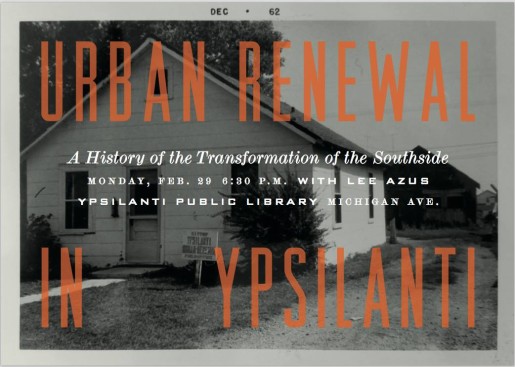I’ve fallen behind in my write-ups of past episodes. I’m sorry about that. I thought, since we were off the air these last two weeks, I’d get caught up, but other things kept getting in the way. [Speaking of which, I may have something relatively big to announce in a few week’s time.] Last night, though, I finally made the time to sit down and listen to this, our 39th episode of the Saturday Six Pack, featuring Democratic candidate for the Michigan House of Representatives Anne Brown, local entrepreneur Bee Roll, and Grammy ward-winning musician Ivan Král, and take some notes. What follows are just a few of the highlights. If you have the time, you should just listen, though. It was a really good episode… the kind that makes me wonder why don’t have a million listeners each week.
ANNE BROWN ON HER CAMPAIGN FOR THE MICHIGAN HOUSE
Our first guest this episode was Ypsilanti City Council member Anne Brown. While we spent a good deal of time discussing her experience on Council, most of our conversation focused on her recently launched campaign for the Michigan House seat being vacated by David Rutledge, who, at the end of this year, will be term-limited out of office. Brown told us about her first experience in politics, as a young volunteer for the gubernatorial campaign of William Milliken, and the circuitous route that led her from a career in public health administration to Lansing, where she’s now worked for 12 years, first working for Representative Alma Wheeler Smith, and then for Representative David Rutledge. [Brown currently serves as Rutledge’s District Manager.]
According to Brown, she was working at Parke-Davis in Ann Arbor twenty-some years ago when she heard something that changed the course of her life. Evidence had come to light showing that that the stillborn rate among African-American women was significantly higher than it was for the rest of the population. And, as Brown told us, she felt compelled to find out why. The reason, as she would soon discover, was low birth weight, and Brown left Parke-Davis to address this issue head on, working as the Executive Director of a non-profit focused on this and other related issues, a position which she would hold for ten years, until deciding to accept an offer from Alma Wheeler Smith to join her team in Lansing and work on public health policy.
Brown said that she’d realized that, no matter how much she did in the community, providing services to those in need, she just couldn’t address the underlying issues through a non-profit. “At the end of the day,” she said, she realized “it’s policies that make the difference.” That, according to Brown, is where you can make significant and long-term headway, and really help people improve their lives.
On the subject of policy, Brown told us that, in her opinion, good laws come into being when legislators set out to address injustice. “You look to see where the injustice is,” she says, “and that’s where you legislate from.” When asked where she sees herself possibly contributing as a member of the Michigan House, Brown discusses a number of issues that are important to her. Given her history, though, it would seem that public health is the area where she’d first like to make her mark, if given the opportunity. [Incoming State Reps don’t choose the committees that they’re assigned to, but Brown says she’d like to serve on the Health Policy committee, as she has ideas for improving how the state interacts with its citizens around health care, increasing affordability and access, and streamlining programs within the Department of Health and Human Services.]
One of my favorite exchanges happened when Brown talked of her daughter, who is now a college sophomore, and the likelihood that she will leave the state upon graduation. Brown said that Michigan isn’t a state where young people see opportunity, and she’d like to help change that by ending “the attack in the working person” that we’ve seen over the past several years.
And, of course, we talked about what she could do for Ypsilanti, if she’s elected. Brown said the most important thing for the future of the city, as she saw it, was the development of Water Street. And she said that, if elected, she would work to ensure that Ypsilanti had Lansing’s support in moving development forward. [We didn’t talk much about it, but, among other things, she mentioned the possibility of at least trying to pursue some degree of debt forgiveness through the state.]
We also talked about the importance of working across the aisle, the possibility of finding areas of commonality with other women in the House, the importance of transparency and accountability, the problem of gerrymandering, and the prospect of actually having a Democratic majority again, thanks in part to the dismal performance of the Snyder administration. And, speaking of which, we talked at length about the situation in Flint… Here’s Brown, toward the end of our conversation, discussing how she wished that there was more of a concerted effort across the state to get Democratic candidates, like herself, talking in similar ways about the issues facing us, and the importance not just of winning individual races, but winning back the House.
[If you would like to listen to episode thirty-nine of The Saturday Six Pack, you can either download it from iTunes or scroll the bottom of the page, where you’ll find the Soundcloud file embedded.]
BEE ROLL ON HER HARD, DARK, BUMPY AND AWESOME YEAR
Then, at the 38-minute mark, just after listening to a song written earlier that same morning in Kenya by our friend Pete Larson, we jumped into a lively discussion with local entrepreneur Bee Roll, the owner of Beezy’s Cafe, about everything from presidential politics to her plans to open a prep kitchen and production facility across the street from her current location on North Washington Street. [I’m pretty sure that, at some point in our conversation, I suggest the possibility of pneumatic tubes connecting her two locations, which could be used to transport pancakes.]
As is usually the case when I talk with Bee, our conversations jumped around quite a bit. One minute we were talking about the t-shirt she wore in last spring’s New York Times piece, and the next she was giving a shout-out to Betty Green for her new haircut. Among other things, we talked about new slang, the current state of the Washington Street corridor, and the controversy surrounding the “Ypsi Real” banners that went up last fall, some of which featured her image.
And, of course, we talked about how her life has changed over this past year, since being named Ypsilantian of the Year by yours truly. We talked about the responsibility that comes along with the title, the process by which we’ll select the next recipient, and the fact that, despite several promises, I’ve yet to have a name plate made for her trophy…. Here’s Bee, showing off yer local haircut, and telling us about her “hard, dark and bumpy” year in the limelight.
IVAN KRAL ON THE ORIGINS OF PUNK
When I arranged, with the help of our mutual friend Steffan Graf, to have Grammy Award-winning musician Ivan Král on the show, I had a pretty good sense of what I wanted to talk with him about.
I thought that, after talking about his early life in Czechoslovakia, and the circumstances that brought him to New York in the 1960s, where his father, a journalist, had been assigned to cover the United Nations, we’d jump immediately forward to the scene that grew up around CBGBs in the early 1970s, and his memories of life inside The Patti Smith Group and Blondie. I thought that a significant part of our hour together would be spent talking about the various characters I’d come to know so well through my books and records, like Tom Verlaine, Richard Hell, and Johnny Thunders, and the circumstances that led to this truly explosive period in American popular culture, during which the word of highly-polished arena rock gave way to the passion and energy of bands like the Ramones. What I wasn’t expecting, however, was for Král to throw me a curve ball during our first few minutes together, telling me that, just after college, as the result of responding to an add for an “office boy” in Manhattan, he found himself working for The Beatles at Apple Corps, joining the organization just as the band was breaking up.
I had done a good deal of research in getting ready for the interview, and I didn’t see this chapter in Král’s life mentioned anywhere. I guess, when you have such an illustrious career in the industry, it can kind of get lost that you started as an “office boy” working for Apple, but I just found it so fascinating that I couldn’t let it go. So a great deal of our time was spent discussing how he went from not being able to find a teaching job in 1970, after graduating from college with degrees in music and French, to pumping gas on Staten Island, to working for The Beatles, and knowing John, Paul, George and Ringo on a first name basis.
I just couldn’t wrap my head around it… how a kid growing up under communism, and listening to bootlegged tapes of Beatles’ songs played over Radio Free Europe and Radio Luxembourg, could, just a few years later, find himself living in New York, working in the office next to Beatles manager Allen Klein, and knowing these men that he’d grown up idolizing. [After the breakup, Klein would continue managing John, George and Ringo, while Paul chose to have Lee and John Eastman, the father and brother of his soon-to-be wife Linda, handle his affairs. Years later, Klein would be fired and sued by his former clients, but Král, I suspect, was long gone by then.]
Král talked about what a dream it was, having grown up in a Soviet bloc country, and having fantasized about the creative independence that these musicians from America and England enjoyed, of then being there, in the office next to Klein, interacting with the members of bands like The Beatles, the Rolling Stones and Herman’s Hermits, all of whom had been clients of Klein’s management company ABKCO. These musicians, he said, represented freedom to him, and, as he was still worried about being sent back to Czechoslovakia, he tried his best to document what was going on around him on film, thinking that, if nothing else, he could take him movies back with him and share them with others who might not understand the power of rock and roll. [The subject of his filming comes up often. For instance, he talked at some length about shooting John and Yoko’s 1972 “One To One” concert at Madison Square Garden.]
It wasn’t all hero worship, though. We also talked about the naiveté at the core of Apple, where decisions were driven by the idyllism and fantastical thinking of The Beatles, who had, over time, surrounded themselves with “yes” people who told them that they could do no wrong. They thought, “We can change the world,” Král said, and they ran the company that way.
We also, of course, talked at length about Patti Smith, who Král clearly still adores. He says he’d heard about this poet who loved Baudelaire and Rimbaud, and had set out to meet her. If I recall correctly, he said he first saw her performing at St. Mark’s Church. Eventually, of course, he’d join Smith’s band, contributing significantly to their brilliant debut album Horses, and those that followed. If I remember correctly, Král told Smith he’d do anything to be in the band, “even play bass.” [I found that funny.] Lenny Kaye, who was with Patti from the very beginning, by the way, has said in the past that they didn’t really become a band until Král joined them.
Discussing how things had taken off for the group, Král attributed a lot of it to good PR, and the fact that Patti had Lisa Robinson behind her, writing about her shows in the Soho News and the Village Voice. Later, he said, the New York Times go onboard. And that’s when people started “descending” on the scene. Clive Davis from Arista started coming to shows. Eventyally Dylan would show up. That, he says, was the only time he remembered seeing Smith even remotely flustered. They played a “cat and mouse” game, he said with a laugh, remembering how they interacted with one another, jockeying for position. [Clive Davis, of course, would offer them a deal at Arista Records, and they would release their first record, Horses, in 1975.]
We talked about the politics of the scene. He said it was collegial, and not very competitive, at least at first. After a while, though, according to Král, things started to change, as copycat bands started appearing on the scene. Before that, however, things were good. All of the bands were so different from one another that there wasn’t much jealousy or competition. Sure, there was some tension, as people left bands to join other bands, but it wasn’t bad. We discussed, for instance, his decision to leave Blondie to play for Smith, and the decision he made years later to stay with Smith after she broke several neck vertebrae during a show in Tampa, Florida. [Smith fell off the stage, dropping 15 feet into a concrete orchestra pit.] Saying that he’d never told anyone else this before, aside from his wife, Král told us that he got a call from Debbie Harry shortly after the accident, asking him if he’d like to go on tour with Blondie, as he knew all of the songs. He said, even though he didn’t know if she’d ever perform again, he chose to pass up the opportunity to rejoin Blondie, and make a lot of money, to stay with Patti through her rehabilitation and see what would happen.
If it’s not coming through here, his love and admiration for Smith is terribly sweet… Calling Smith an amazing artist, Král said that she was incredible to play with, as she could hold everything together by mesmerizing people in the audience. As members of her band, you could make mistakes and it would’t matter. “She was like a shaman,” he added.
Král and I also spent a good deal of time talking about another of his collaborators – Iggy Pop. Upon first seeing the Stooges perform live, Král says he “fell in love” with Iggy, who he calls Jim. [Iggy’s real name, as I’m sure most of you know, is James Newell Osterberg, Jr.] “This is the most gorges man on earth,” Král remembers thinking to himself when he saw Iggy performing under a single spotlight. “I don’t care that I can’t understand the words,” he says, reliving the moment. He was drawn to Jim’s his confidence… Their relationship would grow over time, as Iggy flirted with the idea of producing a record for Luger, which was another of Král’s bands at the time. [Luger, says Král, was more of a glam band, inspired by the likes of Marc Bolan and David Bowie.] Iggy, he said, would come to see him and Patti perform, and come out to his apartment in Jackson Heights to do naughty things with other members of Luger.
And, at some point, he and Iggy began working together. Král says with a laugh that he co-wrote Iggy’s worst album, Party. “I’m a proud writer of the worst record that Iggy ever put out,” he says… Král didn’t know it at the time, but, while he was trying to write a good album, Iggy was trying his best to write an album that would kill a record contract that he wanted out of. So he spent four months writing songs that Iggy would lyrically kill. He says that he got over it a long time ago, though. “I was shocked and amused,” he told us, “not angry.”
There was more… so much more. I can’t, however, get into all of it here. He told us about Johnny Thunders, who he described as “cuddly,” putting honey in his hair before a show. He told us about Dee Dee just staring at a wall and crying before a Ramones show. He told us about meeting Iggy’s father. We talked about what the recent CBGBs movie got wrong. And we talked about how, of all the places in the world, he wound up here, in Ypsilanti, Michigan, just a few miles where Iggy grew up, in a mobile home off of Carpenter Road. [He says he’s here because he fell in love ten years ago.]
I was struck, among other things, by how Král still approaches life. His need to understand and document his surroundings apparently didn’t end in New York City in the 1970s. While he may not be shooting as much film these days, he came across as genuinely interested in this place that he now calls home. He talks of visiting Ypsilanti’s museums and trying to understand what things might have been like here early on. “I love Americana” he says, adding that, even though he’s been in America 50 years, he’s still catching up, and still learning. Michigan is like a country, he says, noting that our population is about the size of Czechoslovakia’s, where he lived until just before 1968, when Communist party officials called in Soviet forces to crush the burgeoning democratic revolution being led by artists and intellectuals. [Party members in Czechoslovakia, he said, asked the Soviets “to betray us.”] At that point, he says, he parents knew that they could never again return home.
I could seriously go on and on forever about the hour Ivan was in the studio with me. We covered an incredible amount of ground. You really should just listen, though. He was truly wonderful.
I would have loved to have talked more, as I felt like we were just scratching the surface, but I felt good about what we covered. As readers of this site know, I very much identify with the music coming out of New York in the early ’70s, and I found it incredibly fun to be able to just sit down and speak with someone who was there, who not only contributed in his own right, but also had the presence of mind to record what he was seeing happen around him as this relatively small group of inspired visionaries reimagined what popular culture could be. [Král would release a compilation of his documentary footage in 1976 under the title Blank Generation.] There was so much more I could have said, but hopefully Ivan will come back and talk with me again in the not too distant future. [I didn’t ever get to ask about David Byrne’s teeth.]
Oh, one last think… I told Král at some point in our discussion about my desire to get Iggy in a car, just driving around Ypsilanti and telling stories from his youth, and he encouraged me to pursue it, saying, “That would be fabulous.”
[One bad thing about this episode… I asked my occasional co-host Jim Cherewick to drop for the final segment, thinking that it would be fun to get him involved in the conversation with Ivan. Unfortunately, though, my inner geeky fanboy took over as soon as Ivan sat down, and I didn’t give Jim a chance to speak. He says he’s not angry, but know that he is.]
Thanks, as always, to AM 1700 for hosting the show, Kate de Fuccio for documenting everything with her camera, and Brian Robb for running the board, making sure the bills paid, and insuring that the toilet paper and bleach stays stocked. [All photos above come courtesy of Kate.]
If you like this episode, check out our archive of past shows at iTunes. And do please leave a review if you have the time, OK? It’s nice to know that people are listening, and, unless you call in, that’s pretty much the only way we know.
Now, if you haven’t already, please listen for yourself, and experience the magic firsthand.
[Episode 39 of the Saturday Six Pack was recorded live on February 6, 2016, in historic downtown Ypsilanti, Michigan, in the studies of AM1700 Radio.]






















